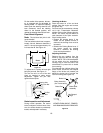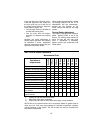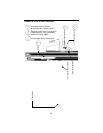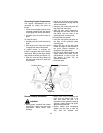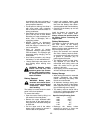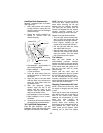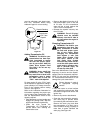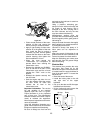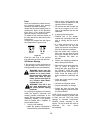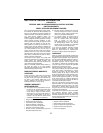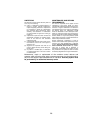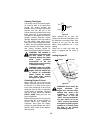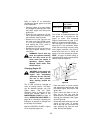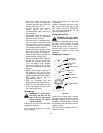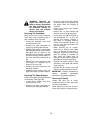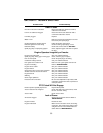
26
Fuse
Fuses are installed to protect the trac-
tor’s electrical system from damage
caused by excessive amperage.
Always use the same capacity fuse for
replacement. Refer to the Specifica-
tions Chart. If the electrical system
does not function, check the fuses.
To replace a fuse, note the position of
the fuse and pull the old fuse from the
electical box.
Compare the suspect fuse with Figure
24 to determine if is good or bad.
Figure 24
Install the new fuse in the position
from which the old fuse was removed.
Off-Season Storage
If the machine is to be inoperative for
a period longer than 30 days, the fol-
lowing procedures are recommended:
WARNING: Never store the
tractor with fuel in the tank
indoors or in poorly venti-
lated enclosures, where fuel
fumes may reach an open
flame, spark or pilot light as
on a furnace, water heater,
clothes dryer, etc.
WARNING: Fuel left in the
fuel tank deteriorates and
will cause serious starting
problems.
To prevent gum deposits from forming
inside the engine’s carburetor and
causing possible malfunction of the
engine, the fuel system must be either
completely emptied, or the gasoline
must be treated with a stabilizer to
prevent deterioration.
1. If using a fuel stabilizer:
• Read the product manufacturer’s
instructions and recommendations.
• Add to clean, fresh gasoline the
correct amount of stabizer for the
capacity of the fuel system.
• Fill the fuel tank with treated fuel
and run the engine for 2-3 min-
utes to get stabilized fuel into the
carburetor.
2. If emptying the fuel system:
• Towards end of the season,
monitor fuel consumption with the
goal of running the fuel tank to
empty.
• If a large volume of fuel is left-
over, remove the fuel cap and
siphon the the bulk of any leftover
fuel into an approved container.
• Run the engine until it starts to
falter, then use the choke to keep
the engine running until all fuel in
the carburetor has been ex-
hausted.
3. Perform the following procedures
before storing the machine.
• Remove the spark plugs and pour
one (1) ounce of engine oil
through the spark plug holes into
the cylinders. Install the spark
plugs but do not connect the plug
wires. Crank the engine two or
three revolutions to distribute the
oil.
• Clean the engine and the entire
tractor thoroughly.
• Lubricate all lubrication points.
• Prepare the battery for storage.
• Protect the tires and seat from
sunlight. Regularly check the tires
for proper inflation.
NOTE: We do not recommend the use
of a pressure washer or garden hose
to clean your unit. They may cause
damage to electrical components;
spindles; pulleys; bearings; or the
engine. The use of water will result in
shortened life and reduce
serviceability.
GOOD
BAD



